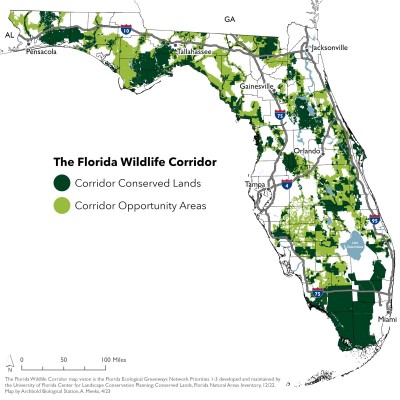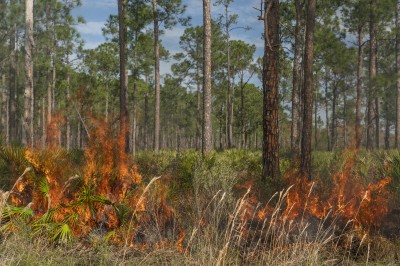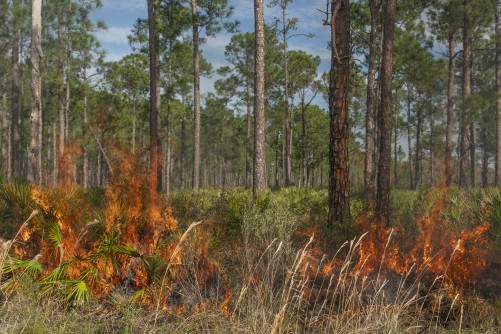Newswise — From rising temperatures and altered precipitation patterns to intense weather events such as hurricanes, Florida is experiencing significant climate-related challenges in tandem with skyrocketing insurance rates. As the state’s population continues to surge by 1,000 new residents a day, it is projected to lose 3.5 million acres of land to development by 2070, threatening Florida’s future ability to maintain biodiversity and ecosystem services.
A first-of-its-kind study highlights how Florida can buffer itself against both climate change and population pressures by conserving the remaining 8 million acres of “opportunity areas” within the Florida Wildlife Corridor (FLWC). Currently, about 10 million acres of the expansive FLWC’s 18 million acres are already conserved permanently.
This superhighway of interconnected acres of wildlands, working lands and waters is the only designated statewide corridor in the United States, and a world-class adaption plan facing down ground zero of climate change in an already warm location. Spanning from Alabama to the Everglades, the FLWC not only protects endangered species like the Florida panther, but also brings economic and climate benefits to local communities. About 90 percent of Floridians live within 20 miles of the corridor.
The new report, “The Florida Wildlife Corridor and Climate Change: Managing Florida’s Natural and Human Landscapes for Prosperity and Resilience,” is a joint project by Florida Atlantic University, Archbold Biological Station, Live Wildly Foundation and numerous collaborators. The report paints a holistic picture of how climate change and population growth will impact Florida’s communities and natural resources, and how the FLWC, if it were fully enacted, can continue to moderate those impacts.
The report offers hope that there are actions public and private partners can take to keep Florida’s lands, waters and communities safe from the worst impacts of climate change. Protecting the FLWC not only shields wildlife from climate change and development, but also supports jobs, economies and ecosystem services such as drinking water and flood protection for people living both inside and outside the corridor.
The FLWC, a critical conservation initiative aimed at preserving natural landscape connectivity across Florida, is the culmination of four decades of research, advocacy and land protection by agencies, landowners and nonprofit organizations that led to the passage of the FLWC Act in 2021. Florida Gov. Ron DeSantis signed the law on July 1, 2021, after votes of 115-0 in favor in the state House and 40-0 in favor in the Senate. In recent years, the Florida Legislature has appropriated more than $2.3 billion to help protect its lands.
“State leadership has demonstrated its understanding of the deep link between clean water, healthy lands and a strong economy by supporting the creation of the Florida Wildlife Corridor and ongoing efforts,” said Colin Polsky, Ph.D., lead author, founding director of the FAU School of Environmental, Coastal and Ocean Sustainability (ECOS) and a professor of geosciences in the Charles E. Schmidt College of Science. “Yet to date, the interactions between the corridor and climate change had not been examined. Findings from our report show substantial climate resilience benefits from the Florida Wildlife Corridor, yielding a much higher return on investment than originally thought.”
Among the report’s key findings:
- Since the FLWC was approved in 2021, private property owners, with the support of state funding, have voluntarily conserved more than 170,000 acres of their lands within the corridor.
- Florida burns more area with prescribed fire each year than any other region of North America, and possibly the world. The more that new housing, infrastructure and other development are scattered across the state, the more difficult it becomes to conduct prescribed burns and manage fire risk. If the corridor is not protected from expanding development, climate change could spark a fire crisis in Florida not unlike that in the western U.S. However, conserving the corridor is not sufficient – funding and policies to allow controlled burns are needed to keep fuel loads from accumulating.
- Twenty-four percent of all Florida properties have a more than 1 in 4 chance of being affected by flooding in the next 30 years. The FLWC provides billions of dollars of flood hazard protection, a vital service as precipitation increases under climate change. A large part of this benefit comes from keeping floodplains undeveloped. About 10 million acres of Florida’s floodplains are located within the FLWC.
- Incentivizing clustered, mixed-use development that takes the FLWC into account will preserve ecosystem services and minimize habitat fragmentation while reducing infrastructure costs.
- The FLWC incentivizes keeping working lands in production, preserving their climate benefits while protecting farmers and billions of dollars of agricultural revenue. Farmers can contribute to climate resilience by implementing climate-smart management solutions. The FLWC helps reduce greenhouse gases and offers the potential for carbon markets.
- Some wildlife species will need to move north to escape higher heat and saltwater intrusion into South Florida’s Everglades. For example, the Florida black bear is being forced to move north to escape higher temperatures caused by climate change. But habitat fragmentation blocks these migratory escape routes. Designating linkages within the FLWC as areas of critical state concern would help ensure that the larger corridor remains a viable means of wildlife movement.
- The FLWC and this report can be models for other regions experiencing growing populations, climate risks and at-risk biodiversity.
“The Florida Wildlife Corridor provides a leading example of ambitious landscape conservation planning on a regional scale. Florida has long been a leader in habitat connectivity planning, and the state should be proud that its efforts inspire others around the world,” said Joshua Daskin, Ph.D., project manager, and director of conservation, Archbold. “The corridor is an example of how public and private partners can come together to achieve mutual economic, social and environmental goals at the local and state levels.”
The FLWC climate report also provides policy recommendations for climate resilience such as limiting coastal, wetland and floodplain development in order to maintain flood mitigation services as well as supporting policies and legislation that integrate climate resilience into land use planning and conservation within the corridor.
“Even though our built environments are responsible for many of the luxuries we enjoy in Florida, our urban design and development choices are fundamental to protecting us from fires, floods, hurricanes, sea level rise and even human health risks such as heat stroke and heat-related death,” said John “Jay’ Baldwin, Ph.D., co-lead author, a professor of biological sciences and associate dean for faculty development, FAU College of Science. “Our report provides a blueprint for planning that will fulfil the economic ambitions of growing Florida communities while mitigating climate change risks and protecting Florida’s people, places and wildlife.”
The FLWC climate report collaborators include Florida State University, University of Central Florida, University of Florida, UF Center for Landscape Conservation Planning, University of South Florida, South Florida Water Management District, reTHINK Energy Florida, and Dover, Kohl & Partners Town Planning.
The report is supported by funding from the Live Wildly Foundation.
- FAU -
About Florida Atlantic University: Florida Atlantic University, established in 1961, officially opened its doors in 1964 as the fifth public university in Florida. Today, the University serves more than 30,000 undergraduate and graduate students across six campuses located along the southeast Florida coast. In recent years, the University has doubled its research expenditures and outpaced its peers in student achievement rates. Through the coexistence of access and excellence, FAU embodies an innovative model where traditional achievement gaps vanish. FAU is designated a Hispanic-serving institution, ranked as a top public university by U.S. News & World Report and a High Research Activity institution by the Carnegie Foundation for the Advancement of Teaching. For more information, visit www.fau.edu.
About Archbold:
Archbold's mission is to build and share the scientific knowledge needed to protect the life, lands, and waters of Florida, and beyond. Archbold’s 20,000 acres and the Headwaters of the Everglades encompass the ancient scrub habitats of the Lake Wales Ridge; the vast, open ranchlands, prairies, and flatwoods of Central Florida; and waterways that flow south into Lake Okeechobee before draining to the coasts. These places are the crucible for Archbold's innovative place-based science, conservation, and education programs, which draw from a long deep history dating back to our founding by Richard Archbold in 1941.
About Live Wildly:
Live Wildly Foundation is a 501(c)3 organization that applies an entrepreneurial approach to the conservation of Florida’s natural resources and wildlife while seeking to balance smart growth, a robust economy and a connected, resilient landscape.
MEDIA CONTACT
Register for reporter access to contact detailsArticle Multimedia

Credit: Archbold Biological Station
Caption: The Florida Wildlife Corridor opportunity areas and conserved lands.

Credit: FAU Center for Environmental Studies
Caption: A graph depicts Florida’s population growth from 2010 to 2020.

Credit: Live Wildly Foundation
Caption:

Credit: Carlton Ward, Jr./Wildpath
Caption: An aerial view of the expansive Florida Wildlife Corridor.

Credit: Jen Guyton
Caption: A prescribed burn at Avon Park Air Force Range.

Credit: Archbold Biological Station and UF/IFAS
Caption: Florida black bear cubs captured by the Corridor Observatory.
Credit:
Caption: Transcript available here

Credit: Archbold Biological Station and UF/IFAS
Caption: Aerials views of the expansive Florida Wildlife Corridor, prescribed burns, and the iconic, endangered Florida panther captured by the Corridor Observatory.
CITATIONS
Conserving the FLWC Needed to Continue Buffering Against Climate Change, Exploding Population






